| Old Organisers |
The electronic organiser is a familiar device nowadays. There's everything from a simple databank with an address book, up to the likes of the Jornada, PalmPilot and iPaq. Some of the older models, however, were quite innovative...
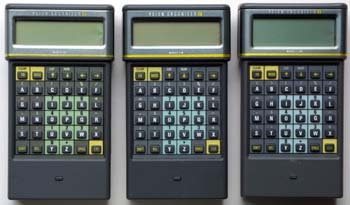
This is the Psion Organiser II, models XP, CM and LZ64 (left to right). They all have a 6303 microprocessor, an LCD, two slots for memory cartridges and a connector for expansion. The keyboard is calculator-like with the keys arranged alphabetically. There's no “off” key — the machine is switched off by a menu command. The case is also styled like a calculator, but it has a handy slide-on cover (not shown in the photo) to keep the keyboard safe when the machine is not in use.
The following Organiser II models were made:
| Model | Display | RAM |
|---|---|---|
| CM | 2 line | 8K |
| XP | 2 line | 16K |
| LZ | 4 line | 32K |
| LZ64 | 4 line | 64K |
The Organiser came with its own proprietary programming language, OPL (for Organiser Programming Language). It's a bit like a structured form of BASIC, and development tools were available for the PC.
See also this Organiser II site.
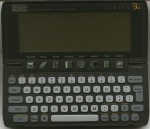
The next model of the Psion Organiser had a quite different layout, opening up to reveal a QWERTY keyboard. This model's display is much more advanced, showing bit-mapped graphics as well as text. The CPU is an NEC V30H at 7.68MHz.
Psion announced in 2001 that they would no longer manufacture personal organisers.
See also Wikipedia on the Psion Series 3.
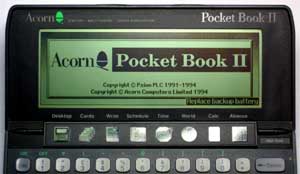
Wait a minute, this is just a re-badged Psion Organiser 3a!
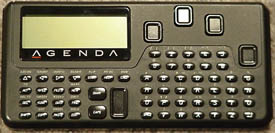
The AgendA is another British-designed organiser from the mid-80s. Its most striking feature is the microwriter keyboard. As if to encourage the use of the microwriter, the conventional keyboard is arranged alphabetically. One of the main design goals was to extend battery life, and that has certainly been achieved. The built-in NiCds would last weeks on a single charge (when they were new).
The microwriter is a descendant of the first chord keyboards, pioneered by Doug Engelbart (inventor of the mouse). Part of the innovation involved in the AgendA was a system of mnemonics to assist in learning the chords. Once the user had learnt the basics, it was possible to move on to more advanced uses of the chord keyboard including a full set of single-chord commands for the machine.
See also the Microwriter AgendA Home Page.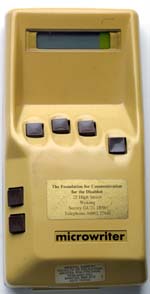
The original Microwriter was not an organiser but a writing machine designed by Cy Endfield and first sold in 1980. It was intended to be used as a text input device, as well as to help the disabled to communicate. It could only show a single line of text on its built-in LED display, but it had interfaces to external display and storage devices. The photo shows a later model with a one-line LCD, released in 1982.
A review of the first version appeared in Personal Computer World magazine in December 1980, and a review of the improved version appeared in September 1982. Both versions sold for £500.
The case is much bulkier than the AgendA, with most of the extra thickness being taken up by the four NiCd batteries. These are fitted into the body of the machine, under the user's palm, but are a non-standard size and soldered into place! The CPU is an RCA 1802.
Both the AgendA and the Microwriter suffer from the problem
of what to do for left-handed users.

The Newton was Apple's entry into the personal organiser market, launched in 1993. It was an amazingly innovative machine at the time, having no keyboard at all but a touch-sensitive screen with handwriting recognition. It also introduces the idea of having a handheld computer as an accessory to a desktop machine, with data being transferred between the two.
The CPU is a 20MHz ARM 610 chip.
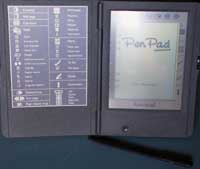
Amstrad's low-cost answer to the Apple Newton. Quite a neat book-like design, with a cover flap opening to reveal LCD on the right and operating instructions on the left. There's a groove on the back where the stylus clips in. It runs on three AA batteries.
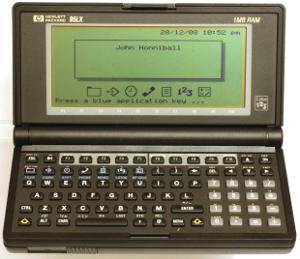
This HP organiser is also an 8088-based PC compatible machine, running MS-DOS. Well, it's PC compatible up to the size of the video display, which has been reduced. But, if you can get MS-DOS programs (.EXE files) onto it, it'll run them quite nicely on two AA batteries. It also has an infra-red port (not IrDA compatible) and a PCMCIA slot. Introduced in 1990.
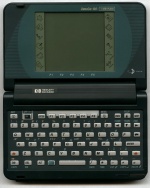
HP's stylus-based organiser of 1995. Uses the same "Graffiti" modified letter-forms as the PalmPilot. Also has a clever square screen that can operate either way round.
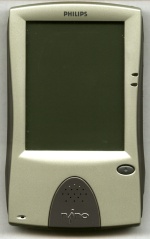
Philips made their stylus-based machine in 1998. It has a slot for Compact Flash (CF) cards, as well as a voice-memo recording feature. Like the Palm Pilot, it has a drop-in docking station for connection to a host PC. The processor in the Nino is a 75MHz MIPS chip, which runs the Windows CE operating system. However, if you prefer Linux, there's always this Nino Linux page.

The Nokia 9110 is a puzzle; is it an Old Organiser or a Massive Mobile? Well, I suppose it's both. The photo shows it opened up into its organiser mode. The processor is a 486, and the OS is GEOS.
Return to the Old Sad Things page
Return to John Honniball's home page
Copyright © 1998-2011 by John Honniball. All rights reserved.